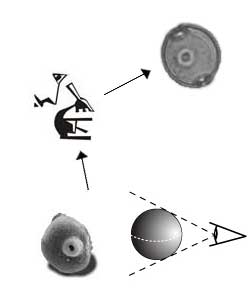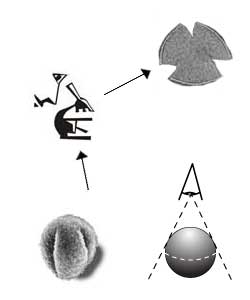The grains were fossilized, underwent a chemical treatment, then were put between a slide and a cover slip. They may be damaged, broken up, or squashed and folded - folds should not be confused with the grain structure.
Examples :
Spores and pollens under the microscope: what is seen and how to observe ?
1. Detect spore and pollen grains
In microscopic preparations spores and pollens extracted from sediments are usually mixed with other objects: artifacts (air bubbles), plant or animal fragments, mineral or humic particles,... |
2. Identify the characteristics of a grain
The grains were fossilized, underwent a chemical treatment, then were put between a slide and a cover slip. They may be damaged, broken up, or squashed and folded - folds should not be confused with the grain structure.
Examples : |
 |
Broken up pollen grain. With some training however, the characteristic pores and internal arcs of Alnus may be recognized. |
 |
Folded pollen grain of Poaceae. |
a. Different possible positions
A grain is a volume, of which the observer only sees one face; a grain may thus appear in different ways.
Examples :
Triporate grain (3 pores), example : Betula |
Tricolpate grain (3 furrows), example: Quercus |
||
 |
 |
 |
 |
b. Explore the whole grain volume by varying fine focus (by rotating the fine focus knob)
The fine focus knob allows the distance between the stage and the objective to be ajusted; by doing this, the focal plane moves up and down through the observed object.
Example 1 - Pinus : pollen with a central body and two small balloons. The focal plane intersects the body, then the balloons.
Example 2 - Plantago : the pores are scattered all over the surface of the grain and are thus at different depths (in different planes). A single focus only allows to see a few pores. By focusing up and down through the grain, all the pores appear successively, which allows them to be counted (identification criterion).
Example 3 - Ericale : group of 4 grains; 3 grains appear in the same plane; the 4th grain appears distinctly by moving down the focal plane.
Example 4 - Cichorioideae : grain covered with spines. When observed from above them, the spines appear as large dots. Such projecting elements appear light at high focus, but become dark when focusing through them. This kind of careful observation allows to analyse the ornamentation of grains.